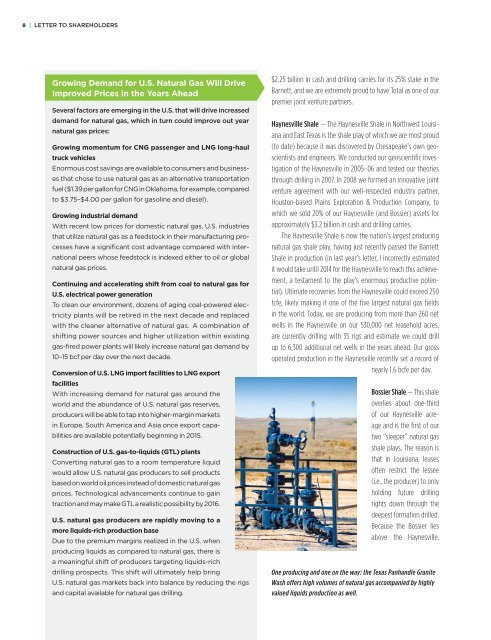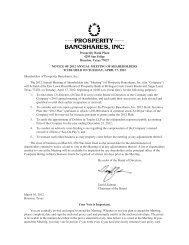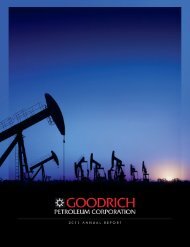6 5 - RR DONNELLEY FINANCIAL - External Home Login
6 5 - RR DONNELLEY FINANCIAL - External Home Login
6 5 - RR DONNELLEY FINANCIAL - External Home Login
Create successful ePaper yourself
Turn your PDF publications into a flip-book with our unique Google optimized e-Paper software.
8 | LETTER TO SHAREHOLDERS<br />
Growing Demand for U.S. Natural Gas Will Drive<br />
Improved Prices in the Years Ahead<br />
Several factors are emerging in the U.S. that will drive increased<br />
demand for natural gas, which in turn could improve out year<br />
natural gas prices:<br />
Growing momentum for CNG passenger and LNG long-haul<br />
truck vehicles<br />
Enormous cost savings are available to consumers and businesses<br />
that chose to use natural gas as an alternative transportation<br />
fuel ($1.39 per gallon for CNG in Oklahoma, for example, compared<br />
to $3.75–$4.00 per gallon for gasoline and diesel).<br />
Growing industrial demand<br />
With recent low prices for domestic natural gas, U.S. industries<br />
that utilize natural gas as a feedstock in their manufacturing processes<br />
have a significant cost advantage compared with international<br />
peers whose feedstock is indexed either to oil or global<br />
natural gas prices.<br />
Continuing and accelerating shift from coal to natural gas for<br />
U.S. electrical power generation<br />
To clean our environment, dozens of aging coal-powered electricity<br />
plants will be retired in the next decade and replaced<br />
with the cleaner alternative of natural gas. A combination of<br />
shifting power sources and higher utilization within existing<br />
gas-fired power plants will likely increase natural gas demand by<br />
10–15 bcf per day over the next decade.<br />
Conversion of U.S. LNG import facilities to LNG export<br />
facilities<br />
With increasing demand for natural gas around the<br />
world and the abundance of U.S. natural gas reserves,<br />
producers will be able to tap into higher-margin markets<br />
in Europe, South America and Asia once export capabilities<br />
are available potentially beginning in 2015.<br />
Construction of U.S. gas-to-liquids (GTL) plants<br />
Converting natural gas to a room temperature liquid<br />
would allow U.S. natural gas producers to sell products<br />
based on world oil prices instead of domestic natural gas<br />
prices. Technological advancements continue to gain<br />
traction and may make GTL a realistic possibility by 2016.<br />
U.S. natural gas producers are rapidly moving to a<br />
more liquids-rich production base<br />
Due to the premium margins realized in the U.S. when<br />
producing liquids as compared to natural gas, there is<br />
a meaningful shift of producers targeting liquids-rich<br />
drilling prospects. This shift will ultimately help bring<br />
U.S. natural gas markets back into balance by reducing the rigs<br />
and capital available for natural gas drilling.<br />
$2.25 billion in cash and drilling carries for its 25% stake in the<br />
Barnett, and we are extremely proud to have Total as one of our<br />
premier joint venture partners.<br />
Haynesville Shale — The Haynesville Shale in Northwest Louisiana<br />
and East Texas is the shale play of which we are most proud<br />
(to date) because it was discovered by Chesapeake’s own geoscientists<br />
and engineers. We conducted our geoscientific investigation<br />
of the Haynesville in 2005–06 and tested our theories<br />
through drilling in 2007. In 2008 we formed an innovative joint<br />
venture agreement with our well-respected industry partner,<br />
Houston-based Plains Exploration & Production Company, to<br />
which we sold 20% of our Haynesville (and Bossier) assets for<br />
approximately $3.2 billion in cash and drilling carries.<br />
The Haynesville Shale is now the nation’s largest producing<br />
natural gas shale play, having just recently passed the Barnett<br />
Shale in production (in last year’s letter, I incorrectly estimated<br />
it would take until 2014 for the Haynesville to reach this achievement,<br />
a testament to the play’s enormous productive potential).<br />
Ultimate recoveries from the Haynesville could exceed 250<br />
tcfe, likely making it one of the five largest natural gas fields<br />
in the world. Today, we are producing from more than 260 net<br />
wells in the Haynesville on our 530,000 net leasehold acres,<br />
are currently drilling with 35 rigs and estimate we could drill<br />
up to 6,300 additional net wells in the years ahead. Our gross<br />
operated production in the Haynesville recently set a record of<br />
nearly 1.6 bcfe per day.<br />
Bossier Shale — This shale<br />
overlies about one-third<br />
of our Haynesville acreage<br />
and is the first of our<br />
two “sleeper” natural gas<br />
shale plays. The reason is<br />
that in Louisiana, leases<br />
often restrict the lessee<br />
(i.e., the producer) to only<br />
holding future drilling<br />
rights down through the<br />
deepest formation drilled.<br />
Because the Bossier lies<br />
above the Haynesville,<br />
One producing and one on the way: the Texas Panhandle Granite<br />
Wash offers high volumes of natural gas accompanied by highly<br />
valued liquids production as well.











